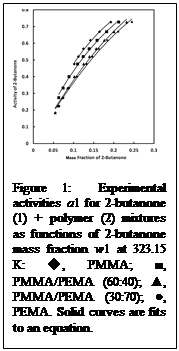Sorption of Organic Vapors by Polymers using a Quartz Crystal Microbalance
Scott W. Campbell, Professor
Department of Chemical & Biomedical Engineering
University of South Florida, Tampa, Florida 33620-5350
Campbell@usf.edu;813.974.3907
 Overview of the Campbell research group: Professor Campbell’s relevant work for this project is in the area of physical property measurement, in particular, fluid phase equilibria. His research group is also involved in the fate and transport of pollutants in the environment, and in engineering education. Here, the emphasis is on the accurate measurement of organic vapor solubility in polymers. These data have industrial applications in chemical engineering such as in the design of reactors, devolatilizers, and environmental applications such as in the outgassing of harmful monomers and solvents from polymers and plastics. Diffusion of organics in polymers is very slow, which means waiting a very long time to attain equilibrium for the measurement of solubility data. A technique for these measurements in very thin layers of the polymer, on the order of 1000 Angstroms, has been developed in the Campbell and Bhethanabotla labs. This is based on the utilization of a solid state device (thickness shear model resonator in quartz) whose frequency shift as a function of vapor sorption will be measured to extract solubility data. A vapor dilution system which can produce multiple dilutions of organic vapors in nitrogen has been constructed and the TSM device, along with associated electronic instruments is integrated with the apparatus.
Overview of the Campbell research group: Professor Campbell’s relevant work for this project is in the area of physical property measurement, in particular, fluid phase equilibria. His research group is also involved in the fate and transport of pollutants in the environment, and in engineering education. Here, the emphasis is on the accurate measurement of organic vapor solubility in polymers. These data have industrial applications in chemical engineering such as in the design of reactors, devolatilizers, and environmental applications such as in the outgassing of harmful monomers and solvents from polymers and plastics. Diffusion of organics in polymers is very slow, which means waiting a very long time to attain equilibrium for the measurement of solubility data. A technique for these measurements in very thin layers of the polymer, on the order of 1000 Angstroms, has been developed in the Campbell and Bhethanabotla labs. This is based on the utilization of a solid state device (thickness shear model resonator in quartz) whose frequency shift as a function of vapor sorption will be measured to extract solubility data. A vapor dilution system which can produce multiple dilutions of organic vapors in nitrogen has been constructed and the TSM device, along with associated electronic instruments is integrated with the apparatus.
Teacher Project: Measurement of Vapor Sorption by Co-polymers
The goal of this project for the teacher is to measure solubilities of several (4-8) solvents in a co-polymer using the above described apparatus. This was constructed as part of the MS theses of two students, and will be made fully functional with the help of a research experiences for undergraduates (REU) student this Spring, 2014. The teacher will make measurements in collaboration with the REU student. Co-polymer sorption data are very limited in the literature. The measurements made by the teacher will be of value in testing and developing models for predicting vapor sorption. These predictive models are useful in designing chemical industrial processes and environmental transport calculations. Examples include the spray drying and hot melt extrusion processes for the formulation of pharmaceutical pills and transport of pollutants in landfill liners. Co-polymers which meet the limitations of the technique, which have industrial significance and which can help with development of models will be chosen. The teacher will validate the dilution apparatus by comparing the theoretically formulated compositions against gas chromatography, make measurements for a range of copolymer compositions, and correlate the measurements with models.
All facilities will be in-place for the teacher to start the project immediately. The first few days will be spent on re-reading a few relevant journal articles and the two MS theses mentioned above (which will be provided ahead of time), understanding the details of the apparatus and discussions with the REU student, and Professor Campbell. Depending upon progress, co-authorship of a journal article is very likely for the teacher, from this project.
- 1. Upconversion Photocatalysis for Energy and Environmental Applications
- 2. Sorption of Organic Vapors by Polymers using a Quartz Crystal Microbalance
- 3. Effective Deposition and Spreading of Powder Layers for 3D Printing
- 4. Synthesis and Characterization of Structured Nanomaterials for Energy Applications
- 5. Syntheses and Characterizations of Catalytically Active Porous Metal-Organic Frameworks (MOFs)
- 6. Microfluidic Filtration of Circulating Tumor Cells
- 7. Simulation and Rational Design of Metal-Organic Materials
- 8. Composition of Organic and Inorganic Polymeric Nanofibers for Filtering, Tissue Scaffolding, Wavelength Reflecting, and Self-healing Functionalities
- 9. Dynamic Tissue Cultures for Cell Printing
- 10. Synthesis and Characterization of Nanocomposites for 3D Printed RF Devices